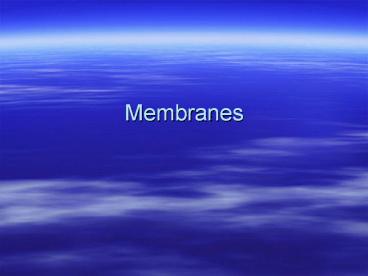Membranes PowerPoint PPT Presentation
1 / 23
Title: Membranes
1
Membranes
2
Cell membrane
- Happened early in evolution.
- Separate cell from its surroundings
- Selective permeability allows only certain
things to cross
3
(No Transcript)
4
Cell membranes
- Membranes fluid mosaics of lipids and proteins
- Amphipathic molecule phospholipids have both a
hydrophilic (head) and hydrophobic (tail) region
also membrane proteins - Hydrophobic portions are hidden in the middle of
the bilayer membrane
5
Lateral movement
- Proteins and lipids can move laterally within the
membrane - Seem to move with specific direction.driven
along cytoskeletal fibers by motor proteins.
6
- Membranes must be fluid to work properly.
- Salad oil
- Cholesterol hinders closeness of the
phospholipids making membrane slightly less fluid
but maintaining fluidness into lower temperatures.
7
Membranes differ
- Membranes with different functions differ in
their makeup. - Mitochondria have more embedded proteins
8
Membrane transport
- Hydrophobic not charge can dissolve partially
cross - Hydrophilic more difficult
9
Cell Wall plants
- Cell wall
- Cellulose
- Proteins
- Polysaccharides
- Pectin (starch)
10
Cell Membrane
- Cell Membrane (animal)
- Phospholipid bilayer
- Imbedded proteins protein channels
- Cholesterol
- Glycoproteins cell to cell recognition
11
Membrane transport
- Hydrophobic no charge, non polar
- If small CO2, O2 can dissolve and cross easily
- Hydrophilic polar more difficult H2O, glucose
12
Passive transport
- Passive transport diffusion, osmosis,
facilitated diffusion (uses transport protein) - Diffusion tendency of molecules to spread out
due to their kinetic energy. - Substances will diffuse down their concentration
gradient - Unaffected by the concentration of other
substances.
13
Membrane transport Facilitated
- Facilitated diffusion H2O, glucose
- Transport Proteins may be hydrophilic inside
- Carrier may physically move substrate
- Aquaporins for H2O
- May be substrate specific or may just span the
membrane
14
Membrane Transport facilitated
- Transport protein
- Protein channel
- Ion channels usually gated. Need chemical or
electrical stimulus - Protein carrier
15
Osmosis
- Osmosis diffusion of water passive
- Water down its concentration gradient
- Hypotonic to Hypertonic less
solute(more water) more solute
16
- Cell wall lets in only so much water until cell
is turgid (healthy for plant) - Animal cell with no wall will burst if put in
hypotonic solution.
17
Active transport
- Sodium potassium pump
- Pumping solutes against their concentration
gradient. - Cell inside K high Na low
- Must use energy to maintain this balance
- ATP phos. Group might bind directly to the
transport protein
18
Na K pump
- Na binds with protein causes ATP to ADP
- The added phosphate changes protein shape
- So, protein spits Na out the other side and
grabs K - K binding releases the Phosphate
- 3 Na out and 2 K in
19
Voltage
- Cell membrane have voltage
- Membrane potential electrical potential energy
due to the charges in and out of cell ( - inside
outside) - Animal electrogenic pump (Na, K)
- Plants use proton pump
20
- 2 forces drive diffusion
- Membrane potential electrical energy
- Concentration gradient chemical energy
21
Cotransport
- Plant pumps H out
- When it diffuses back in it can carry sucrose
with it. (even against concentration gradient)
22
Exocytosis
- Exocytosis vesicle fuses with cell membrane to
release it secretions outside
23
Endocytosis
- Membrane forms vesicle with something from
outside - 1. phagocytosis pseudopodium then fuse with
lysosome - 2. pinocytosis wrap around drop of
extracellular fluid - 3. receptor mediated humans- cholesterol ligand
any molecule that binds to receptor

